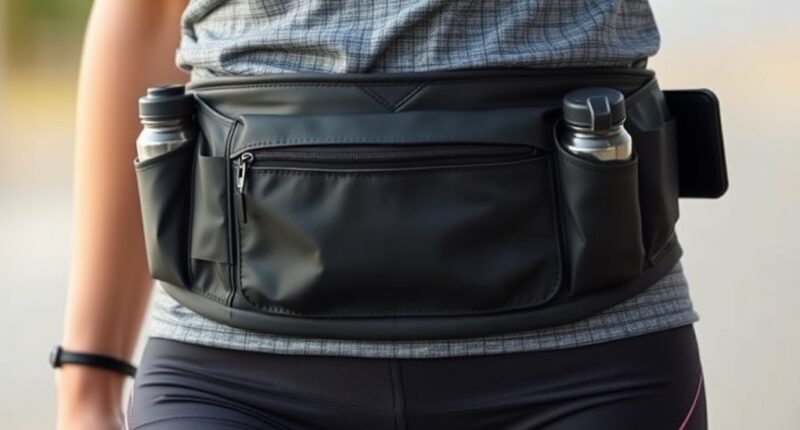To set up your running belt for zero bounce, choose a snug but comfortable fit with an adjustable strap, and guarantee it sits flat against your waist. Position heavier gear near the center or back for stability and lighter items on the sides for quick access. Use grip materials or silicone strips to prevent shifting and test your setup with a short run, making adjustments as needed. Keep improving your setup to stay secure and comfortable throughout your run.
Key Takeaways
- Measure your waist accurately at the narrowest part and select a belt that fits snugly without restricting movement.
- Distribute gear evenly, placing heavier items near the center/back and lighter essentials on the sides or front.
- Adjust the belt gradually until it feels snug but comfortable, ensuring it stays flat and secure during activity.
- Use silicone grips, clips, or extra anchoring methods to increase friction and prevent shifting or bouncing.
- Regularly check and re-tighten the belt during runs, especially on longer distances, to maintain zero bounce and comfort.
Choose the Right Running Belt for Your Needs
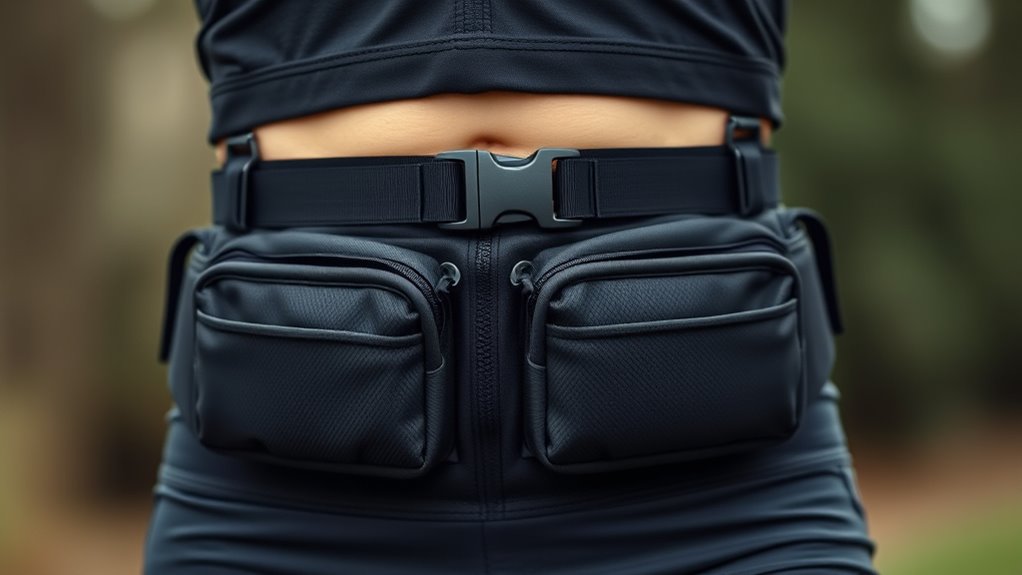
Choosing the right running belt depends on your specific needs and running habits. You should consider fabric choices, as breathable, lightweight materials prevent overheating and chafing during long runs. Look at belt styles to find one that fits comfortably and suits your activity level. Some belts feature smooth, elastic fabrics for a snug fit, while others use more structured materials for added durability. Decide if you want a minimalist design or one with multiple pockets for gear storage. The right fabric and style will keep your essentials secure without bouncing or causing discomfort. Take time to compare options, focusing on how the fabric feels and how the belt fits your body type. This guarantees you select a belt that stays in place and meets your running needs. Additionally, understanding fabric composition can help you choose a belt that is both comfortable and durable over time, especially considering performance fabrics designed for active wear. Being aware of ergonomic design features can further enhance comfort and reduce movement during your runs. Also, selecting a belt with adjustable straps can help customize the fit to prevent bounce and improve stability.
Adjust the Belt for a Snug Fit

To get the perfect fit, start by measuring your waist accurately. Then, use the adjustable straps on your belt to tighten it until it feels snug but comfortable. This makes certain your belt stays secure without restricting your movement. Additionally, ensuring the belt’s fit is important for comfort and stability, especially during high-impact activities. Remember, a well-fitted belt can also help prevent unwanted bounce or shifting, improving your overall running experience. Proper adjustment can also minimize false alarms or discomfort, which are common issues with poorly fitted security gear. Just as stability in a relationship benefits from clear boundaries and communication, a secure belt relies on proper fit to maintain its function.
Measure Your Waist Properly
Before adjusting your running belt, it’s vital to measure your waist accurately. Using a flexible tape measure, find the narrowest part of your waist, usually just above your belly button. Keep the tape snug but not tight to guarantee an accurate waist measurement. This step is essential for proper sizing accuracy, helping you select a belt that fits securely without being too tight or too loose. Avoid guesswork—measure twice if needed to confirm your waist size. Knowing your precise waist measurement allows you to adjust the belt for a snug fit, preventing bounce and discomfort during your run. Remember, a well-measured waist ensures your running belt stays in place, providing comfort and stability mile after mile.
Use Adjustable Straps
Once you’ve measured your waist, you can begin adjusting the belt’s straps to achieve a secure fit. Use the adjustable straps to customize the belt tension, making sure it’s snug but comfortable. Proper strap customization allows you to tighten or loosen the belt as needed, preventing bounce while running. Make small adjustments until the belt feels secure around your waist without restricting movement or causing discomfort. Check the fit by jogging in place or moving around; if the belt shifts or bounces, tighten the straps further. Remember, the goal is a snug, personalized fit that keeps your essentials secure. Adjusting the straps carefully ensures your running belt stays in place, providing comfort and zero bounce during your workout. Incorporating a proper fit enhances comfort and effectiveness during exercise. Additionally, choosing a wireless system can reduce clutter and improve mobility, making your run more comfortable.
Position Your Items Correctly

Ensuring your items are correctly positioned on your running belt can make a significant difference in comfort and accessibility during your run. Proper accessory placement helps balance weight distribution, reducing bounce and discomfort. Place heavier items, like a phone or keys, closer to your center to maintain stability. Lighter essentials, such as gels or snacks, can go on the sides or front for quick access. Use the table below to visualize ideal placement:
| Item Type | Placement Location | Tips |
|---|---|---|
| Phone | Center or back | Keep secure, easily reachable |
| Keys | Slightly to the side | Prevent bouncing |
| Gels/Snacks | Front or side | Quick access, balanced load |
| Small accessories | Top or inside compartments | Avoid shifting during run |
| Water bottles | Side holders | Distribute weight evenly |
Use Compression or Grip Materials

Using compression or grip materials on your running belt can substantially enhance comfort and security during your run. Compression materials, like stretchy fabrics, help your belt stay snug without slipping, reducing bounce. Grip fabrics, such as silicone or rubberized textures, provide extra friction to keep items in place. Choose a belt with these features to prevent shifting or bouncing, especially as you pick up pace. These materials also help your gear stay secure through varied weather conditions and long distances. When shopping, look for belts with high-quality grip fabrics and elastic compression zones. Incorporating these materials ensures your belt maintains a tight fit, minimizes movement, and keeps your essentials stable, so you can focus on your run without distraction or discomfort.
Test Your Setup With a Short Run
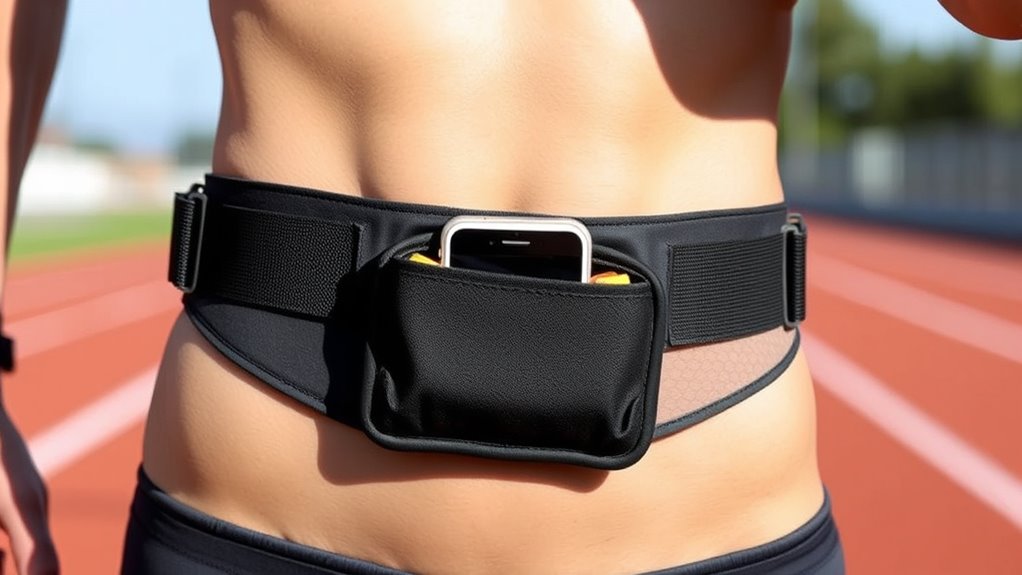
Before committing to longer runs, it’s essential to take your setup for a test spin with a short run. Focus on how your running belt feels during movement, paying attention to any bounce or discomfort. Check that your running shoe fit is secure enough to support your stride without restricting movement, as an improper fit can affect your stability. Also, evaluate your hydration pack selection—ensure it sits snugly without shifting or bouncing, especially if it’s loaded. During this short run, notice if your gear remains in place or if you need to tighten any straps. This quick test helps you identify and address issues early, so your setup stays zero bounce and comfortable throughout longer runs.
Tighten and Readjust During Your Run
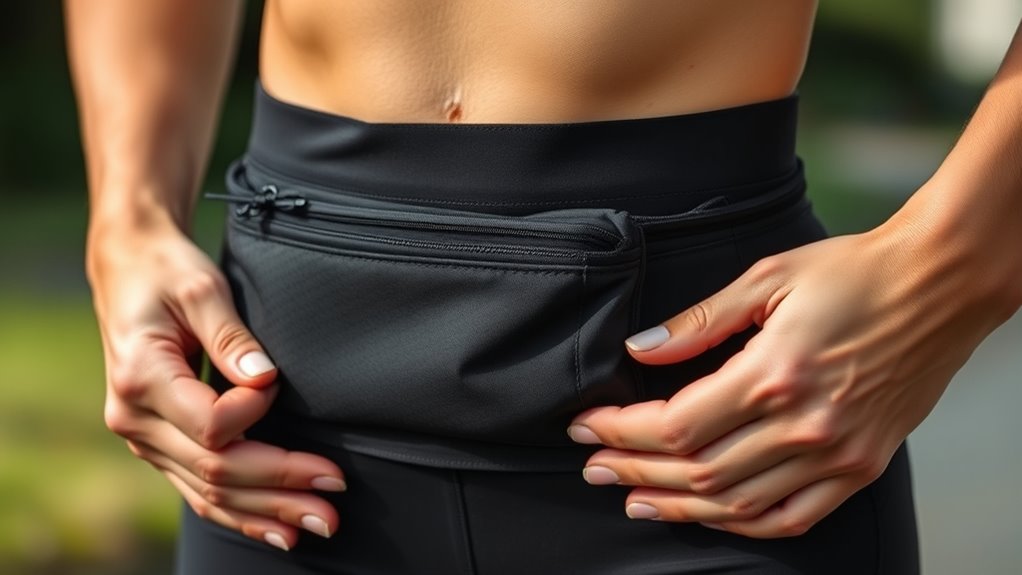
As you progress through your run, it’s important to stay attentive to how your gear feels and make quick adjustments as needed. If your belt shifts or starts bouncing, tighten it slightly to maintain a snug fit. Remember, belt material plays a role here—stretchy or rigid fabrics respond differently to tension, so adapt accordingly. Keep an eye on belt aesthetics; a well-fitted belt should look smooth and secure, not bulky or uneven. Don’t hesitate to readjust during your run if you notice any movement. A quick tighten here or a minor repositioning can make a big difference in preventing bounce and discomfort. Staying proactive with these tweaks keeps your gear comfortable and ensures your focus stays on your run.
Consider Additional Anchoring Options
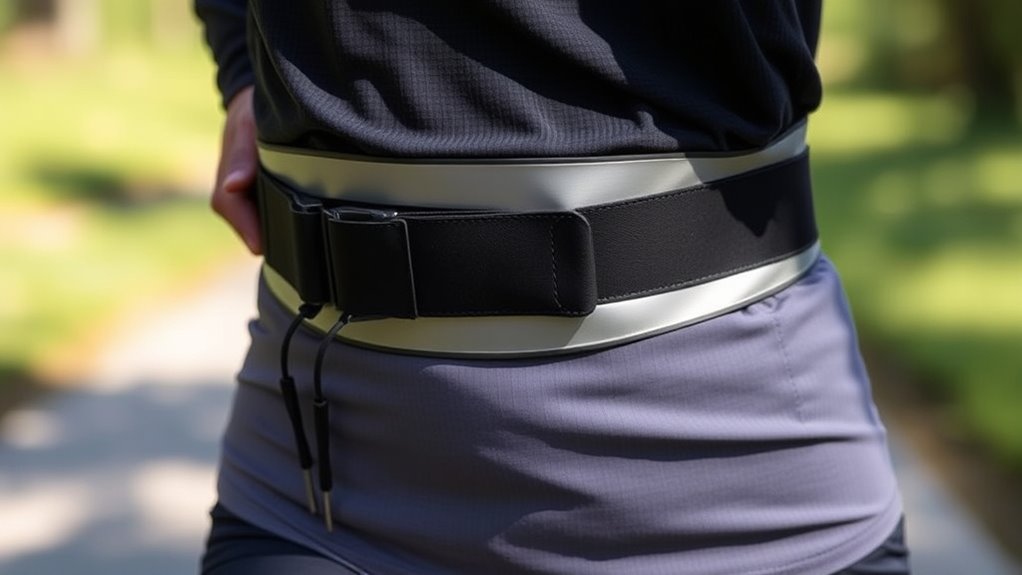
To prevent your running belt from shifting or bouncing, consider adding extra anchoring options. Alternative anchoring methods can provide the added stability you need for a secure fit. First, try using silicone grips or strips on your belt to increase friction against your clothing, reducing movement. Second, attach small carabiners or clips to secure any loose ends or excess material, preventing slippage. Third, opt for a belt with adjustable straps or compression features that tighten around your waist, offering a customizable fit. These options enhance stability without sacrificing comfort, ensuring your belt stays put during your run. Incorporating these additional anchoring techniques helps you stay focused on your workout, not readjusting your gear.
Maintain Proper Posture and Running Form

Maintaining proper posture and running form is essential for maximizing efficiency and preventing injuries. Keep your shoulders relaxed and aligned with your hips to avoid tension. Focus on upright posture, engaging your core to support your spine. Practice effective breathing techniques—breathe deeply from your diaphragm to supply oxygen efficiently and reduce fatigue. Proper breathing also helps maintain rhythm and stability. Hydration strategies are equally important; stay well-hydrated before, during, and after your run to prevent cramping and ensure ideal muscle function. Avoid slouching or overextending your arms, which can throw off your balance and cause bounce. By consciously maintaining good form and using correct breathing and hydration strategies, you’ll enhance your running experience while keeping your belt stable and bounce-free.
Regularly Check and Readjust Your Belt
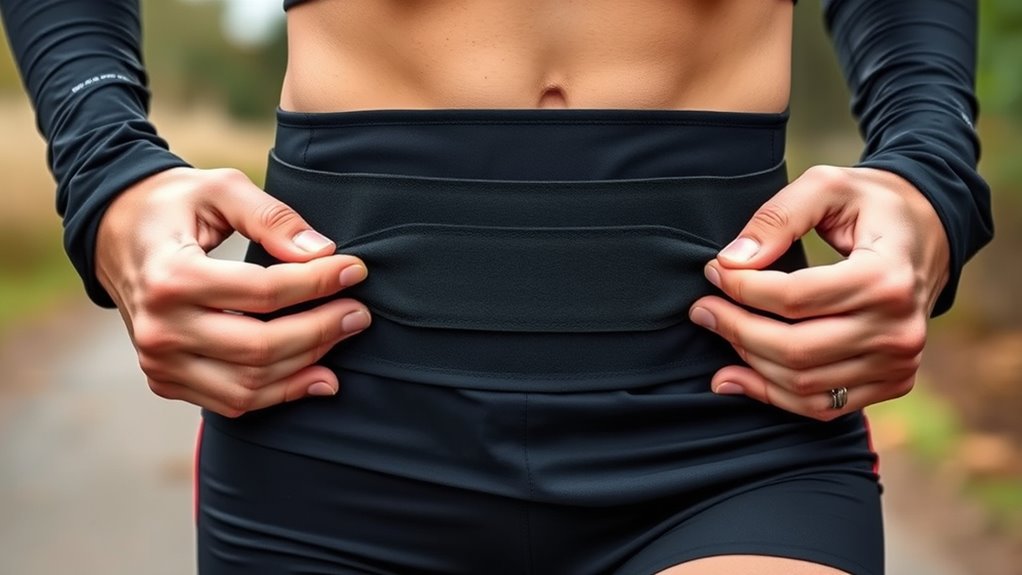
Make it a habit to check your belt’s fit before each run to guarantee it stays snug but comfortable. If you notice any slipping or tightness, readjust the straps to keep everything secure. Regularly monitoring and tweaking your belt helps prevent distractions and keeps your gear in place.
Monitor Belt Fit
How often should you check your running belt to guarantee it fits properly? Regularly monitoring ensures comfort and prevents bounce. Start by inspecting the belt material—ensure it’s durable and snug without causing chafing. Next, verify the belt color remains visible and doesn’t fade, which indicates wear. Finally, check the fit by performing these steps:
- Ensure the belt sits flat against your waist without gaps.
- Confirm it feels snug enough to stay in place during movement.
- Adjust if the belt shifts or bounces, even slightly.
Adjust Straps Regularly
Regularly checking and readjusting your running belt’s straps keeps it fitting perfectly as your body moves and conditions change. Over time, strap material can stretch or shift, affecting the belt’s stability. By fine-tuning the straps, you guarantee they stay snug without causing discomfort or bouncing. Don’t forget to contemplate belt aesthetics—dirt or wear can make it look less appealing and impact how securely it stays in place. Adjust the straps so they’re tight enough to prevent bounce but not so tight that they restrict movement or cause chafing. Consistent adjustments help you maintain a comfortable, secure fit, especially during longer runs or changing weather conditions. Making this a regular habit keeps your belt performing at its best, no matter how intense your workout gets.
Incorporate Additional Gear if Needed

Depending on your running distance and personal needs, you might find it helpful to incorporate additional gear into your belt setup. Proper gear customization guarantees you carry only what’s necessary without sacrificing comfort or stability. When selecting items, consider the belt material; flexible, lightweight options reduce bounce and chafing. Here are three key items to consider adding:
- Small hydration flask for longer runs
- Energy gels or snacks for sustained effort
- Reflective patches or lights for safety
Adding these items can improve your running experience, but make sure your belt can securely hold them without shifting. Adjust the placement and tightness to minimize bounce. Remember, the goal is a balanced setup that adapts to your gear needs while maintaining zero bounce.
Frequently Asked Questions
How Tight Should My Running Belt Be for Optimal Comfort?
For ideal comfort, you should adjust your running belt tension so it’s snug but not too tight. It shouldn’t chafe or restrict movement, so aim for a fit that holds your essentials securely without bouncing. When choosing your belt, consider material selection—stretchy, moisture-wicking fabrics offer better comfort. Regularly check and tweak the tension during your run to guarantee it stays in place and feels comfortable throughout your workout.
Can I Wear My Running Belt Over or Under Clothing?
You can wear your running belt over or under clothing, depending on your layering techniques and style considerations. Wearing it over clothing offers easy access and minimizes skin chafing, while under clothing provides a sleek look and extra protection. Consider your comfort and the weather when choosing. Experiment with both options to find what works best, ensuring your belt stays secure without causing discomfort or bounce.
What Materials Help Prevent Bouncing During High-Impact Runs?
You want materials that prevent bouncing during high-impact runs, so look for ones with good shock absorption and material flexibility. Neoprene and nylon are excellent because they absorb shock and stretch comfortably with your movements. These materials help keep your running belt stable, reducing bounce even at high speeds. Choose a belt with a snug fit made from flexible, shock-absorbing fabrics to stay comfortable and secure throughout your run.
How Often Should I Check My Belt During a Run?
Imagine you’re on a long trail run, and suddenly your belt feels loose. You should check your belt adjustment every 15-20 minutes during your run to prevent bouncing. Make emergency checks if you notice discomfort or gear shifting. Regularly adjusting your belt keeps it secure and comfortable, ensuring your focus stays on running, not readjustments. Staying vigilant helps avoid chafing or gear loss, making your run safer and more enjoyable.
Are There Specific Belt Designs Better for Long-Distance Running?
For long-distance running, look for belts with bungee straps that provide a snug, adjustable fit, preventing bounce over miles. Consider designs with reflective accents for safety during early morning or evening runs. These features guarantee comfort and visibility, making your run more enjoyable. Choosing a belt with these elements helps you stay secure and confident, so you can focus on your performance without worrying about shifting or discomfort.
Conclusion
By following these tips, you’ll turn your running belt into a rock-solid, bounce-proof fortress that defies gravity itself! Say goodbye to jiggling, bouncing, and annoying distractions—your gear will stay so perfectly in place, you’ll think you’re gliding on air. With the right setup, you’ll feel like a superhero zipping through your run, unstoppable and unshakeable. Get ready to conquer every mile with zero bounce—your new superpower starts now!
